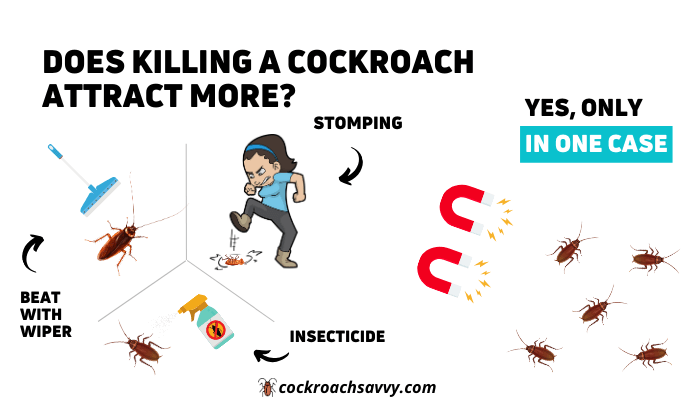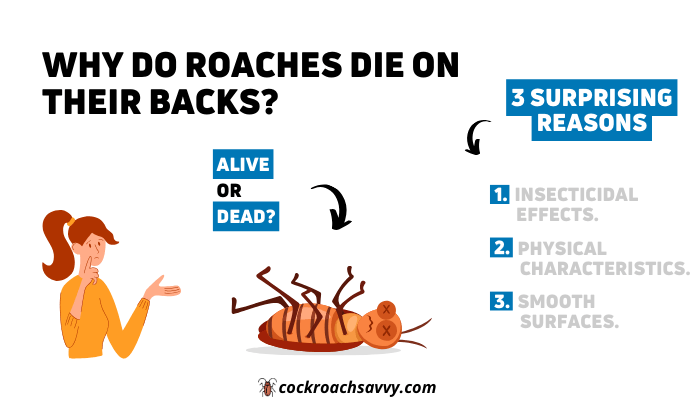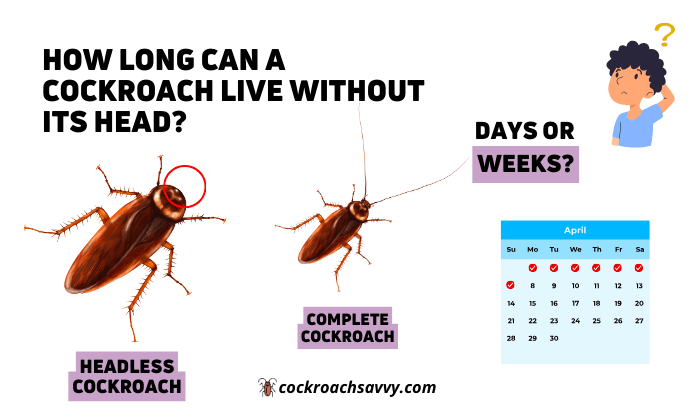Have you ever encountered yourself face-to-face with a big brown bug in your washroom, under your sink, or in any other moist area in your home?
If so, you may be wondering what kind of bug it is.
With so many different species of water bugs out there, it’s no wonder that identification can be confusing.
Unfortunately, the information available is not always easy to understand, leaving many people scratching their heads.
But fear not!
We’re here to help make the process of water bug identification a little bit easier for you.
So, let’s get started and find out just what kind of bug has been causing all the commotion in your home!
Are water bugs cockroaches?
“Water bug” isn’t a particular kind of bug, but a regionally-inspired nickname for certain type of cockroaches – peridomestic roaches that prefer to live outdoors but infest homes when they choose or need to.
Water bug is actually a term many people use to refer to roaches, but it doesn’t refer to all cockroaches, Only the peridomestic cockroaches (the American, Oriental, and smoky brown roaches) that prefer to live outdoors.
Peridomestic cockroaches are a type of cockroach that can live and reproduce both indoors and outdoors. They are often found in areas such as wet sewers, moist trash dumps, and humid compost around our homes.
In warmer regions, most of the time these cockroaches live outdoors in close proximity to water but may migrate indoors, into wet sewers or basements in the fall when the weather starts to get cooler.
Other than peridomestic cockroaches, there’s another type of water bug The giant water bug (a true water bug) – which isn’t a cockroach at all.
The Gaint Water bug and cockroaches are similar, in the way that they are both insects and they both live in damp environments, but they are not the same thing.
However, most people who talk about water bugs are actually talking about one of several species of outdoor cockroaches listed below.
First, let’s identify the giant water bug and then cockroaches/water bugs.
The Giant Water Bug – the One Who Isn’t Interested in Your House
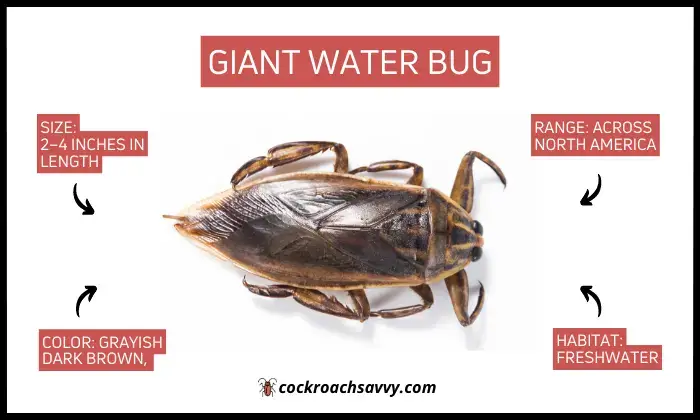
The giant water bug (Lethocerus americanus) is a large, aquatic insect that belongs to the order Hemiptera, which also includes insects such as cicadas, aphids, and other true bugs.
It is also known by the common names “toe biter” and “electric light bug” due to its size and habit of being attracted to porch lights.
The giant water bug is native to North and Central America, and it is commonly found in bodies of water such as ponds, lakes, and streams.
Despite its scary appearance and predatory habits, the giant water bug is not aggressive toward humans and is not known to bite or sting.
It is typically found in open, sunny areas of ponds and lakes, and is most active during the warmer months of the year. While it is sometimes seen crawling on porch lights, it is not interested in entering or infesting your house.
It is a predatory insect, and it uses its strong front legs to capture and hold onto its prey, which can include aquatic insects, small fish, amphibians, and some are known to kill prey many times of their own size
The giant water bug injects toxic saliva into its prey, which can paralyze it and make it easier to eat.
Characteristics :
- Size: 2–4 inches in length
- Color: Grayish dark brown, similar to a dead leaf
- Range: Across North America, especially southern Canada and the U.S.
- Habitat: Freshwater, including ponds, streams, and the edges of lakes
- Risks: A giant water bug has been known to bite humans when handled.
American Cockroaches (The American Water Bug)
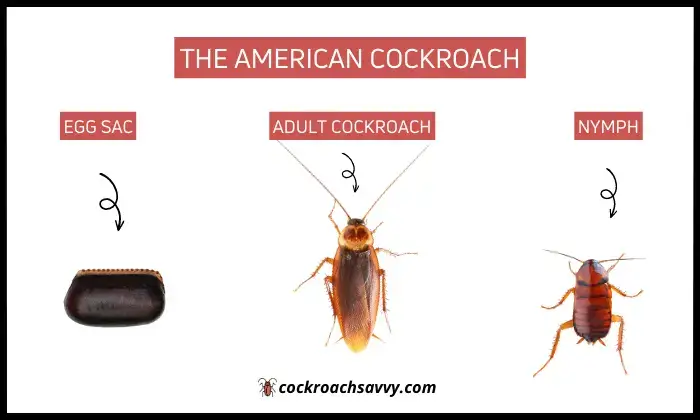
American cockroaches, most commonly known as water bugs, are the largest pest roach in America. It has a reddish-brown color and a yellowish band at the bottom of its wings.
They are about 1.5 inches (3.5 cm) long and have a pair of wings, both sexes can fly, but poorly over long distances. Instead, they use their wings to glide short distances.
American cockroaches thrive in dark and moist environments such as basements and sewers.
Also, the American cockroach is a nocturnal insect and is most active at night when it searches for food and water. They are known to feed on a variety of organic matter like trash, waste, and other decaying organic material.
To identify an American cockroach, look for a reddish-brown insect with a yellow band around the base of its wings and a large, flat body.
Characteristics :
- Size: 1.5–2 inches in length.
- Color: Reddish brown with yellow markings behind its head.
- Range: Across the U.S., in areas both urban and rural.
- Habitat: Outdoors in dark, warm, damp environments, such as sewers and drain pipes; indoors in kitchens and bathrooms, near food and water.
- Risks: American cockroaches are known to be carriers for diseases and spread harmful bacteria and organisms wherever they go with their disgusting feces and shedding body parts!
The American Water Bug Nymph :
American cockroach nymphs, also known as baby cockroaches, are about 1/8 inch long when they are born. They look like small versions of adult cockroaches, except that they do not have wings. (As shown in the picture above)
Upon completing their last molt, they are equipped with wings and the ability to reproduce. This complete transformation takes anywhere from six months to more than a year.
During this time, they go through several molts about six times as nymphs, shedding their exoskeletons and growing larger with each molt. By the time they reach adulthood, they are about 1.5 inches long.
Oriental Cockroaches

Oriental cockroaches are dark brown or black in color and are about one inch long.
They can be identified by their shiny appearance and their long, narrow shape.
Unlike other cockroach species, Oriental cockroaches have small wings, but they cannot fly.
Oriental cockroaches are often found in cooler, damp, and dark areas such as basements and sewers. They are also known to feed on garbage and other decaying organic matter.
To identify an Oriental cockroach, look for a dark-colored, shiny insect with long, narrow wings.
Characteristics :
- Size: 1 – 1.5 inches
- Color: Shiny dark brown or black
- Range: Around the world, especially the northwest, midwest, and southern U.S.
- Habitat: Cool, humid environments, like basements, piping, laundry rooms, and dumpsters.
- Risks: An Oriental roach can lay 115 eggs per year, so the risk of infestation is high.
- They can survive on garbage and unsealed food, spreading widely in homes via pipes and cracks in walls.
- The bacteria they carry can cause stomach illnesses. They also produce a musty stench that’s difficult to eliminate.
The Oriental Cockroach Nymph :
Oriental Water Bug nymphs are small, and wingless that are often mistaken for other types of cockroach nymphs.
Oriental cockroach nymphs are dark brown or black in color and have a shiny appearance. The maturing time of Oriental cockroach nymphs is about a year.
To better understand what an oriental cockroach’s nymph looks like, see the above picture.
Smoky brown Cockroaches
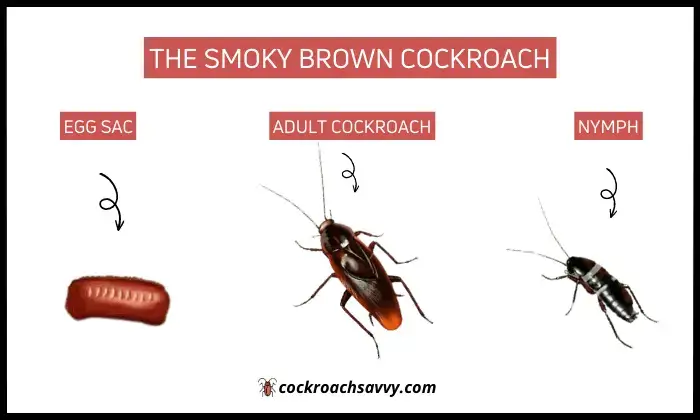
Smoky brown cockroaches are attracted to lights and can be recognized by their uniform dark brown or black color.
They are typically about 1.5 inches in length and have wings that are longer than their body, making them good flyers.
Another distinctive feature of smoky brown cockroaches is their long antennae, which are almost as long as their body.
They are also commonly found in outdoor areas, such as gardens and wooded areas.
Characteristics :
- Size: 1.25 – 1.5 inches
- Color: Uniform dark or mahogany brown
- Range: Across the U.S., especially the Southeast
- Habitat: Warm, humid areas, like attics, water meter boxes sewer access openings, and roof shingles.
Smoky brown Cockroach Nymphs
Smoky brown cockroach nymphs can be identified by their small size (usually around 1/4 to 1/2 inch long), dark brown or black color, and long, thin antennae.
They sometimes also have a distinct smoky or dark brown coloration on their wings.
Nymphs may be found in damp or moist areas, near food sources, or in areas with high levels of organic debris.
The smoky brown cockroach Nymphs require about 320 days from egg to adult.
The German Cockroach – Not to Be Confused with a Water Bug
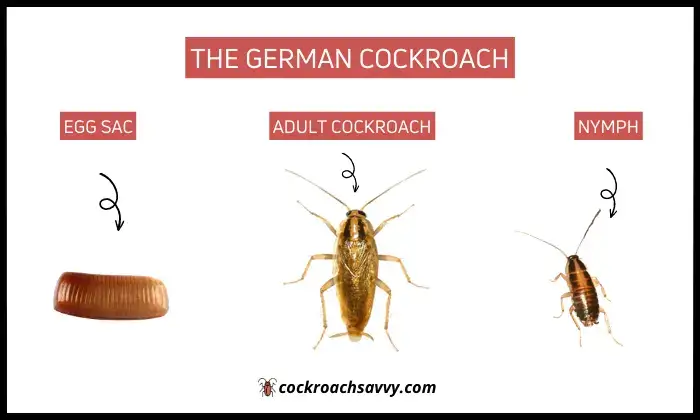
Despite the fact that German cockroaches are not water bugs nor peridomestic cockroaches, they are so prevalent as household pests that some individuals group them together.
Unlike other roaches on this list, German cockroaches are a common indoor species, known for their ability to hide in tight spaces and multiply quickly.
As they are so small and due to their capability of multiplying quickly, exterminators consider them to be the most difficult species to control.
The German cockroach is a small, light brown cockroach with two dark stripes on its thorax.
They are normally about 1.3 to 1.6 cm long.
To identify this species of cockroach, look for the following characteristics:
Characteristics :
- Size: Small size (about 1.3 to 1.6 cm in length)
- Color: Light brown, tan, or golden with a pair of dark, vertical stripes on its back
- Range: Across the U.S, in close proximity to people
- Habitat: Warm, humid areas of homes, businesses, and shared living complexes
- Appearances: Two dark stripes on the thorax Long, slender antennae
- Risks: High risk of infestation, as German roaches take around 6 to 31 weeks to reach adulthood.
- These pests are able to hide and reproduce in numerous locations, leading to rapid multiplication and the spread of harmful bacteria throughout your home.
- German cockroach skins and droppings can cause allergic reactions and trigger asthma symptoms.
If you are still unsure whether you have found a German cockroach,
You can also look for other identifying characteristics, such as the presence of wings (which the German cockroach has) or the shape of the body (which is elongated and oval-shaped in the German cockroach).
You can also try to identify the cockroach by its behavior; German cockroaches are nocturnal and are often found in moist, warm areas such as near sinks and kitchen cabinets.
German Cockroach Nymphs
To identify German cockroach nymphs, look for small, oval-shaped insects that are about 1/8 to 1/4 of an inch long.
Which is usually dark brown or black in color and have two horizontal stripes on their thorax.
Other than that, German cockroach nymphs have wings that are not fully developed, so they are unable to fly.
Another way to identify these insects is to look for their egg capsules, which are small and brown and are carried by female roaches.
The eggs inside the capsule are pale in color and can be seen through the transparent outer shell. (As shown in the picture above)
Before you go…
Identifying the right Cockroach aka Water bug is just the first step.
Even seeing a single cockroach in your home can infest your whole home later.
To roach-free your home, if there are any or to protect your home from future roach infestation.
Reading below articles may help you…
Peppermint Oil for Roaches: A Proven and Natural Remedy
Essential Oils for Roaches: A Non-Toxic Solution for Pest Control
What Smells Repel Cockroaches: 10 Most Effective Smells
FAQS
Where Do Water Bugs Live?
Water bugs, like giant water bugs, are aquatic insects that live in freshwater ponds, lakes, and slow-moving streams.
You can find them in temporary pools of water, such as those that form after heavy rain, or near the bottom of the water where they can hide among plants and debris.
While the Water bugs, like peridomestic cockroaches (the American, Oriental, and smoky brown roaches) are typically found in kitchens, bathrooms, and basements, as they are attracted to warm, moist environments, they are often found near sources of water, such as sinks and drains.
Do water bugs eat roaches?
Yes, water bugs like giant water bugs eat cockroaches.
In fact, they are known to prey on a wide variety of insects, as well as small fish and amphibians.
Although cockroaches aren’t part of their daily diet because most of the time roaches live on dry lands.
How big are water bugs?
True giant water bugs are usually 2 inches long.
But some can grow quite large, reaching lengths of up to 4 inches, with large front legs and a wide, oval-shaped body.
While the cockroaches commonly called “water bugs” range from about ½ inches to over 2 inches in length.
The most common species, the German cockroach, is ½ to 5/8 inch (13 to 16 mm) long
Are Water Bugs harmful?
Water bug aka Gaint Water Bug will attack brutally if they sense any danger! Their bites pack a punch and are seriously painful, but thankfully, they aren’t a threat to us humans. Don’t confuse them with pests, though – they actually feast on other insects, not people.
Water bugs, aka Cockroaches, are a health hazard. They spread allergens and trigger asthma attacks. Their presence on food items is dangerous as they carry deadly bacteria that can cause fatal illnesses. The WHO warns that these pests are carriers of devastating intestinal diseases like dysentery, diarrhea, cholera, and typhoid fever
Why do water bugs come out in the summer?
These annoying creature water bugs are typically drawn to warm, moist environments, so it’s likely that they are more active in the summer because the warmer temperatures create conditions that are conducive to their survival and reproduction.
For water bugs like cockroaches, summer is the season of love. They breed in warmer months, and higher temperature helps their offspring thrive
How do water bugs get in the house?
Water bugs aka cockroaches can enter a house through small cracks and crevices, open doors and windows, and other points of entry.
They are also known to hitch a ride inside boxes, bags, and other items brought into the home.
In some cases, they may even be introduced into a home through the plumbing or sewer system.


